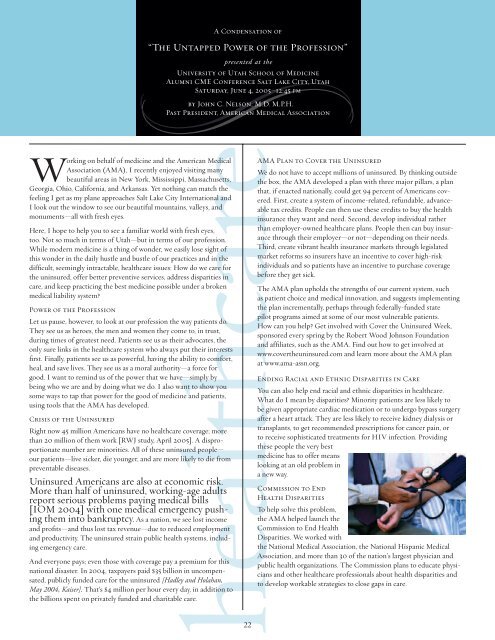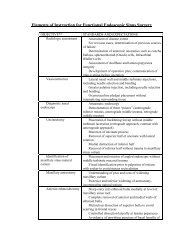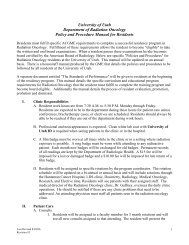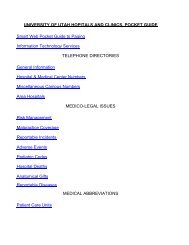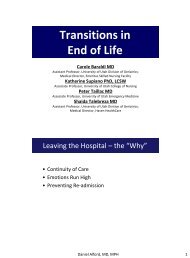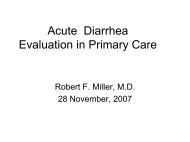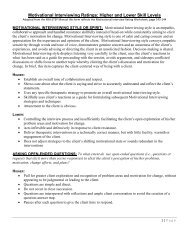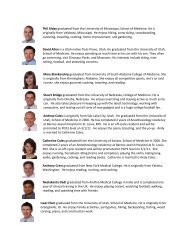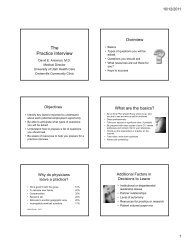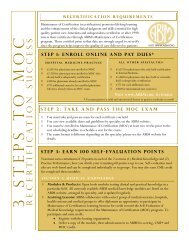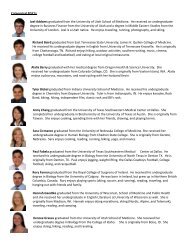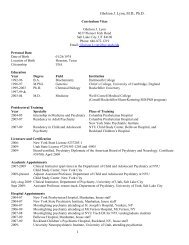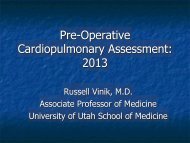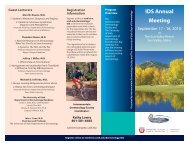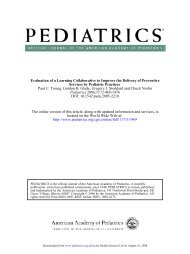2005 Centennial Issue - University of Utah - School of Medicine
2005 Centennial Issue - University of Utah - School of Medicine
2005 Centennial Issue - University of Utah - School of Medicine
Create successful ePaper yourself
Turn your PDF publications into a flip-book with our unique Google optimized e-Paper software.
Condensation <strong>of</strong><br />
presented at the<br />
A<br />
“The Untapped Power <strong>of</strong> the Pr<strong>of</strong>ession”<br />
<strong>University</strong> <strong>of</strong> <strong>Utah</strong> <strong>School</strong> <strong>of</strong> <strong>Medicine</strong><br />
Alumni CME Conference Salt Lake City, <strong>Utah</strong><br />
Saturday, June 4, <strong>2005</strong>–12:45 PM<br />
by John C. Nelson, M.D. M.P.H.<br />
Past President, American Medical Association<br />
healthcare<br />
Working on behalf <strong>of</strong> medicine and the American Medical<br />
Association (AMA), I recently enjoyed visiting many<br />
beautiful areas in New York, Mississippi, Massachusetts,<br />
Georgia, Ohio, California, and Arkansas. Yet nothing can match the<br />
feeling I get as my plane approaches Salt Lake City International and<br />
I look out the window to see our beautiful mountains, valleys, and<br />
monuments—all with fresh eyes.<br />
Here, I hope to help you to see a familiar world with fresh eyes,<br />
too. Not so much in terms <strong>of</strong> <strong>Utah</strong>—but in terms <strong>of</strong> our pr<strong>of</strong>ession.<br />
While modern medicine is a thing <strong>of</strong> wonder, we easily lose sight <strong>of</strong><br />
this wonder in the daily hustle and bustle <strong>of</strong> our practices and in the<br />
diffi cult, seemingly intractable, healthcare issues: How do we care for<br />
the uninsured, <strong>of</strong>fer better preventive services, address disparities in<br />
care, and keep practicing the best medicine possible under a broken<br />
medical liability system?<br />
Power <strong>of</strong> the Pr<strong>of</strong>ession<br />
Let us pause, however, to look at our pr<strong>of</strong>ession the way patients do.<br />
They see us as heroes, the men and women they come to, in trust,<br />
during times <strong>of</strong> greatest need. Patients see us as their advocates, the<br />
only sure links in the healthcare system who always put their interests<br />
fi rst. Finally, patients see us as powerful, having the ability to comfort,<br />
heal, and save lives. They see us as a moral authority—a force for<br />
good. I want to remind us <strong>of</strong> the power that we have—simply by<br />
being who we are and by doing what we do. I also want to show you<br />
some ways to tap that power for the good <strong>of</strong> medicine and patients,<br />
using tools that the AMA has developed.<br />
Crisis <strong>of</strong> the Uninsured<br />
Right now 45 million Americans have no healthcare coverage; more<br />
than 20 million <strong>of</strong> them work [RWJ study, April <strong>2005</strong>]. A disproportionate<br />
number are minorities. All <strong>of</strong> these uninsured people—<br />
our patients—live sicker, die younger, and are more likely to die from<br />
preventable diseases.<br />
Uninsured Americans are also at economic risk.<br />
More than half <strong>of</strong> uninsured, working-age adults<br />
report serious problems paying medical bills<br />
[IOM 2004] with one medical emergency pushing<br />
them into bankruptcy. As a nation, we see lost income<br />
and pr<strong>of</strong>i ts—and thus lost tax revenue—due to reduced employment<br />
and productivity. The uninsured strain public health systems, including<br />
emergency care.<br />
And everyone pays; even those with coverage pay a premium for this<br />
national disaster. In 2004, taxpayers paid $35 billion in uncompensated,<br />
publicly funded care for the uninsured [Hadley and Holahan,<br />
May 2004, Kaiser]. That’s $4 million per hour every day, in addition to<br />
the billions spent on privately funded and charitable care.<br />
22<br />
AMA Plan to Cover the Uninsured<br />
We do not have to accept millions <strong>of</strong> uninsured. By thinking outside<br />
the box, the AMA developed a plan with three major pillars, a plan<br />
that, if enacted nationally, could get 94 percent <strong>of</strong> Americans covered.<br />
First, create a system <strong>of</strong> income-related, refundable, advanceable<br />
tax credits. People can then use these credits to buy the health<br />
insurance they want and need. Second, develop individual rather<br />
than employer-owned healthcare plans. People then can buy insurance<br />
through their employer—or not—depending on their needs.<br />
Third, create vibrant health insurance markets through legislated<br />
market reforms so insurers have an incentive to cover high-risk<br />
individuals and so patients have an incentive to purchase coverage<br />
before they get sick.<br />
The AMA plan upholds the strengths <strong>of</strong> our current system, such<br />
as patient choice and medical innovation, and suggests implementing<br />
the plan incrementally, perhaps through federally-funded state<br />
pilot programs aimed at some <strong>of</strong> our most vulnerable patients.<br />
How can you help? Get involved with Cover the Uninsured Week,<br />
sponsored every spring by the Robert Wood Johnson Foundation<br />
and affi liates, such as the AMA. Find out how to get involved at<br />
www.covertheuninsured.com and learn more about the AMA plan<br />
at www.ama-assn.org.<br />
Ending Racial and Ethnic Disparities in Care<br />
You can also help end racial and ethnic disparities in healthcare.<br />
What do I mean by disparities? Minority patients are less likely to<br />
be given appropriate cardiac medication or to undergo bypass surgery<br />
after a heart attack. They are less likely to receive kidney dialysis or<br />
transplants, to get recommended prescriptions for cancer pain, or<br />
to receive sophisticated treatments for HIV infection. Providing<br />
these people the very best<br />
medicine has to <strong>of</strong>fer means<br />
looking at an old problem in<br />
a new way.<br />
Commission to End<br />
Health Disparities<br />
To help solve this problem,<br />
the AMA helped launch the<br />
Commission to End Health<br />
Disparities. We worked with<br />
the National Medical Association, the National Hispanic Medical<br />
Association, and more than 30 <strong>of</strong> the nation’s largest physician and<br />
public health organizations. The Commission plans to educate physicians<br />
and other healthcare pr<strong>of</strong>essionals about health disparities and<br />
to develop workable strategies to close gaps in care.


